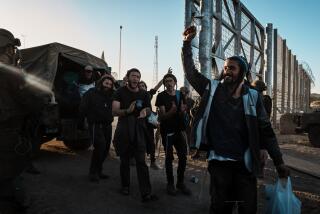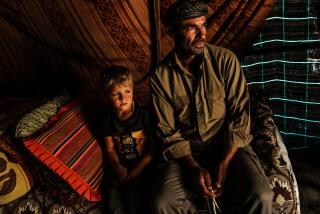Spirit of Saladin Lives in Arab Public Relations Crusade : Israelis Face a Tough Opponent in 800-Year-Old General
- Share via
TEVERYA, Israel — The four middle-aged Israeli reservists lounged in the shade of a small grove of olive trees not far from here, at the site of one of history’s most famous military engagements. Their dusty Jeeps were parked nearby and their assault rifles lay on the ground beside them.
“I’m a friend of Saladin,” one of the soldiers quipped, referring to the 12th-Century Kurdish general and Muslim hero. “We just chased the Crusaders out of here.”
He was speaking at the spot where historians say Guy of Lusignan, the Latin king of Jerusalem, made a futile last stand around his regal red tent 800 years ago this summer. When Guy’s tent finally fell, and he surrendered to Saladin, it sealed the fate of the Crusades and marked the end of one of the most remarkable periods in the saga of the Holy Land.
Which side, a reporter asked, did these 20th-Century Israeli fighting men think the Jews would have been on in that long-ago battle between Muslims and Christians?
“They would have been with the United Nations,” the unit commander responded diplomatically.
Actually, there is evidence that the few Jews who were still in this area in the 12th Century were on Saladin’s side. And that makes it even more ironic that, 800 years later, the battle at the Horns of Hattin, a mountain about five miles west of Teverya, is a political bone of contention between Israelis and the region’s mostly Muslim Arabs.
To many Arabs, and particularly to the Palestinians from this area, the Israelis are not Jews returning after 2,000 years to their ancestral homeland, but Western interlopers with no more business here than, as they see it, the Crusaders had.
It is a key element of Arab ideology that, just as Saladin turned back the Crusaders at the Horns of Hattin, they will one day end Israeli domination of what used to be Palestine.
The main street in largely Arab East Jerusalem is named after the Muslim general, as are schools and avenues in many towns on the Israeli-occupied West Bank.
“After Saladin conquered Palestine and chased the Crusaders off our lands, the Crusaders returned to take revenge,” an Arab schoolboy from the West Bank town of Janin recently told an Israeli television interviewer.
And who are the Crusaders of today? the interviewer asked.
“The new imperialists,” the boy replied. “The Jews.”
Another Janin youngster put in: “We hope that a figure like (Saladin) will appear and do things like he did.” The greatest of Muslim heroes, he added, “should not remain a memory only.”
A worried Arab teacher told the Israeli interviewer that such views are not taught in school, that the boys must have learned them at home.
East Jerusalem’s Arabic-language newspaper Al Fajr has also drawn a parallel between the 12th Century and the present. A number of Arab countries, including Egypt, Iraq and Syria, organized forums last month to mark the anniversary of the battle at the Horns of Hattin, the paper noted in an editorial. And it was made clear at them all, it said, that “we must concentrate on the lesson of Hattin: Arab unity and Arab solidarity to prevent collapse.”
Israeli historians generally dismiss as unimportant such efforts to politicize the historic battle. But it clearly angers others here. In the course of an interview on another subject the other day, a senior Israeli politician criticized the Israeli television report on the anniversary as evidence of what he called a defeatist attitude.
Emmanuel Sivan, a political scientist and Middle East expert, said Saladin was recruited to the Palestinian side of the Arab-Israeli conflict in the early years of this century, when the area was still under Turkish rule. A caricature of the time showed the 12th-Century leader pushing away a would-be Jewish land buyer with his sword.
In the 1930s the Palestinian movement celebrated “Saladin Day,” and when Israel invaded Lebanon in 1982, the Palestine Liberation Organization billed it as a new “Crusade.”
“One looks at the Crusader Kingdom differently through Jewish than through Muslim eyes,” said Motti Dolev, 37, a farmer, area supervisor for Israel’s Nature Reserve Authority and student of the Crusader period.
Accompanying a visitor on a tour of the battle site, Dolev mused: “The Crusader knew he had a family in Europe. He had no roots here. He didn’t really merge with the area. And we don’t behave like that.”
The battleground is actually a modest hill, with slight peaks on the north and south that form the “horns.” The black rock and traces of lava near the base testify that the hill was once a volcano. Today it stands innocently in the midst of a religious kibbutz named Lavi, on the sun-baked highlands about 1,500 feet above the Sea of Galilee.
The horns offer a commanding view of the terrain for miles around, and presumably this is why the Israeli army occasionally sends out a contingent of reservists to look around. To the east it is possible to see the Golan Heights, where Israeli troops are deployed opposite the forces of Israel’s most implacable enemy, Syria. Syrian President Hafez Assad reportedly keeps a large painting of the battle of the Horns of Hattin on a wall of his office in Damascus.
Whether history was made at the Horns of Hattin because of a Crusader blunder or because of Saladin’s brilliant generalship is a matter of dispute.
The Crusades had begun almost a century earlier, in 1095, when Pope Urban II called on Europeans to go forward as “knights of Christ” to defend the Eastern Church, then under attack by Muslim Turks. His plea touched off so sweeping a popular movement that, it is said, anyone alive today who is of West European descent must have a Crusader or a Crusade supporter in his family tree.
But by the summer of 1187 the Muslims were united under Saladin, and they were marching on the Crusader stronghold at Tiberias, or Teverya, as it is now called.
The main body of the Crusader army, believed to number about 20,000, was camped at Zippori Springs, near Nazareth. And when Saladin swept west from Damascus and around the southern tip of the Sea of Galilee, King Guy of Jerusalem faced a dilemma.
It would be disastrous for the heavily armored Crusaders to leave their water supply and march in the heat of summer to engage Saladin’s larger and more mobile force, he was warned. But Tiberias could not hold out alone.
Moreover, according to Benjamin Kedar, a Hebrew University historian and Crusader specialist, Guy “was in a difficult position because he was new in his job--elected under questionable circumstances as king only a few months before.”
“He had a strong opposition to deal with,” Kedar said. “He had been in a similar situation four years earlier, as Regent of the Kingdom, and he decided not to go into battle. . . . That was the right strategic decision, but he was heavily criticized for it and he lost the regency. So four years later he must have been telling himself: ‘I can’t do it again. This time I must show my worth.’ ”
So the Crusader king led his army east, only to bog down within a day because of the heat, the lack of water and harassment by Saladin. By dawn on July 4, 1187, the Muslim army had surrounded the Crusaders and set fire to the parched brown fields around the Horns of Hattin in order to further immobilize them.
By the end of the day, it was clear that the Crusaders had made a fatal mistake in deciding to leave the Zippori Springs.
“They say that even a year later there were corpses on the north side of the hill,” Dolev said. “The Muslims write different things. They say this was all brilliant, planned army maneuvers. Maybe (the version faulting Guy) was written through Jewish eyes.”
Historian Kedar said that Crusader error and Saladin’s strategy both contributed to the outcome. What is not in doubt is that the battle at the Horns of Hattin belongs in any anthology of history’s fateful military engagements.
“It was the end (for the Crusaders) because all their fortresses were denuded of defenders,” Kedar said. “Everybody went to Hattin. So once that battle was lost, the kingdom fell to Saladin without any real opposition.”
As for the sympathies of the Jews at the time, Kedar insists that there is no question. “Of course” they would have been on Saladin’s side, he said.
The first Crusaders set the tone for the period even before they left for the Holy Land in 1096 when they massacred 800 Jews at Worms in what is now West Germany. Saladin, by contrast, is said to have issued a decree immediately after conquering Jerusalem in October, 1187, inviting the Jews to return to their holy city.
Also, Kedar said, at least one diary of the time, kept by an Englishman, records that local Muslims and Jews pursued the Crusaders retreating from Hattin toward the coast.
Kedar organized the second international conference of the Society for the Study of the Crusades and the Latin East, which met at the Horns of Hattin last month. The group, which included 70 foreign experts, climbed to the south horn to view the latest scientific evidence of the Muslim victory unearthed here.
This was the remnants of Saladin’s Dome of Victory, a monument erected just after the battle. Israeli archeologists identified the ruins only weeks before the conference, Kedar said.
More to Read
Sign up for Essential California
The most important California stories and recommendations in your inbox every morning.
You may occasionally receive promotional content from the Los Angeles Times.













